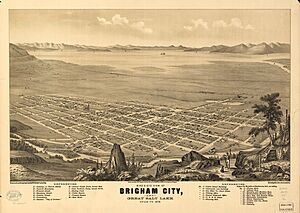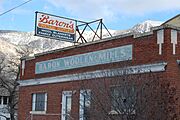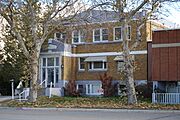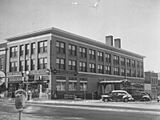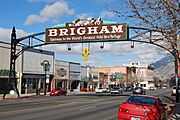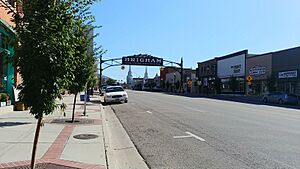Brigham City, Utah facts for kids
Quick facts for kids
Brigham City, Utah
|
|
|---|---|
|
City
|
|
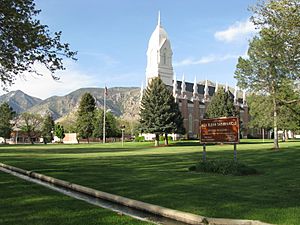
The Box Elder Stake Tabernacle is one of 28 sites in or near Brigham City listed on the National Register of Historic Places
|
|
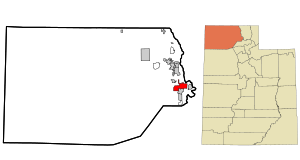
Location in Box Elder County and the state of Utah
|
|
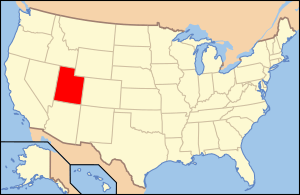
Location of Utah in the United States
|
|
| Country | |
| State | |
| County | Box Elder |
| Settled | 1851 |
| Named for | Brigham Young |
| Area | |
| • Total | 24.92 sq mi (64.54 km2) |
| • Land | 24.58 sq mi (63.67 km2) |
| • Water | 0.34 sq mi (0.88 km2) |
| Elevation | 4,232 ft (1,290 m) |
| Population
(2020)
|
|
| • Total | 19,650 |
| • Density | 788.5/sq mi (304.46/km2) |
| Time zone | UTC−7 (MST) |
| • Summer (DST) | UTC−6 (MDT) |
| ZIP code |
84302
|
| Area code(s) | 435 |
| FIPS code | 49-08460 |
| GNIS feature ID | 2409910 |
Brigham City is a city in Box Elder County, Utah, United States. In 2020, about 19,650 people lived there. It is the main city of Box Elder County.
The city sits on the western side of the Wellsville Mountains. These mountains are part of the Wasatch Range. Brigham City is also known for its peaches! Every year, after Labor Day, the city holds a big event called Peach Days. Main Street closes for a parade, a car show, and a carnival.
The Church of Jesus Christ of Latter-day Saints opened its 14th temple in Utah here in 2012. Brigham City is also home to the Golden Spike State Historical Monument. You can also find one of the campuses of Utah State University here. The city is the main office for the Northwestern Band of the Shoshone Nation, a Native American tribe.
Contents
History of Brigham City
How Brigham City Began
A pioneer named William Davis first explored the Brigham City area in 1850. He came back a year later with his family and others to build homes. In 1853, Brigham Young asked Lorenzo Snow to lead more settlers to the area. Their goal was to create a city that could support itself.
Lorenzo Snow was in charge of both religious and city matters. He named the settlement Box Elder in 1855. On January 12, 1867, the town officially became a city. Its name was changed to Brigham City to honor Brigham Young. That same month, Chester Loveland became the town's first mayor. Brigham Young gave his last public speech here in 1877.
World War II and Beyond
During World War II, the city got a big economic boost. The government built Bushnell General Hospital in Brigham City. This hospital treated soldiers who were hurt in the war. Local people sold food and supplies to the hospital. The hospital staff also supported local businesses.
After the war, the hospital buildings became the Intermountain Indian School. Many young Native Americans went to this boarding school. It closed in 1984. Today, many of the old hospital buildings are still standing. Some have become businesses or apartments. Utah State University bought the site in 2013. They plan to expand their Brigham City campus there.
Brigham City's Economy Today
A big part of Brigham City's economy comes from Thiokol. This company makes missiles and the solid rocket boosters for the Space Shuttle. Another company, Autoliv, also provides many jobs. They make airbags. Nucor Corporation has two facilities in Brigham City. A Walmart distribution center nearby also brings new jobs.
Historic Places to See
Baron Woolen Mills
This mill was built in 1870. It made high-quality blankets and sweaters from local wool. Sadly, it was damaged by a fire in 2014 and completely destroyed by another fire in 2015.
Cooley Memorial Hospital
Dr. A.D. Cooley opened this hospital in 1935. It was the only hospital in Brigham City until 1976. That's when the Brigham City Community Hospital opened.
Hotel Brigham
This hotel was built for railroad workers. The rooms were cheap, and most didn't have bathrooms. James Knudson, a former mayor, was one of the first owners.
Brigham City Archway Sign
This famous sign was put up on September 6, 1928. Citizens donated $2,400 to pay for it. The sign stretches across Main Street. It welcomes visitors to the business area. The sign says "Gateway to the World's Greatest Wild Bird Refuge."
Brigham City Cemetery
The cemetery was started in 1853. It's a peaceful place with old-fashioned grave markers. Many pioneers and early residents are buried here. It has many grand old trees.
Geography and Climate
Where is Brigham City?
Brigham City is in southeastern Box Elder County. It's on the western side of the Wellsville Mountains. These mountains are part of the Wasatch Range. Brigham City is seen as the northern end of the Wasatch Front. To the west, there's a flat desert area. This area eventually leads to marshlands near the Great Salt Lake.
Major highways like I-15 and I-84 pass west of the city. U.S. 89 and U.S. 91 also meet in the city. The city also has bus service from Ogden. It will be the northern end of the FrontRunner commuter train line.
The city covers about 24.92 square miles (64.54 square kilometers). Most of this area is land. It sits at an elevation of about 4,232 feet (1,290 meters).
Brigham City's Weather
Brigham City's weather is like the rest of the Wasatch Front. It's usually a bit cooler. Winters have a lot of snow, averaging about 38 inches (97 cm) each year. Summers are hot, but the air isn't very humid. Nights are cool. Winters are cold, but rarely extremely freezing. May is usually the wettest month, and July is the driest.
People of Brigham City
In 2000, there were 17,411 people living in Brigham City. The population grew to 19,650 by 2020. The average age in the city was 29 years old.
Religions in Brigham City
- Latter-day Saint - 80.5%
- Unaffiliated (no specific religion) - 14.4%
- Catholic - 2.9%
- Protestant - 2.1%
- Other - 0.2%
Arts and Culture
Brigham City has some interesting places to visit. The Brigham City Museum-Gallery shows local art and history. The Box Elder Museum focuses on natural history. There is also an LDS tabernacle and a temple downtown.
Nearby Attractions
- Golden Spike National Historic Site: This important historical site is northwest of the city. It's where the first transcontinental railroad was completed.
- Spiral Jetty: This famous land art project is west-southwest of the city.
- Bear River Migratory Bird Refuge: This wildlife refuge is directly west of Brigham City. It's a great place to see many different kinds of birds.
Fun Festivals
- Brigham City Arts Festival
- Fourth of July Celebration
- Brigham City Peach Days
Education in Brigham City
Public Schools
Brigham City is part of the Box Elder School District. Here are some of the schools:
- Box Elder High School (Grades 10-12)
- Sunrise High School (Alternative Grades 10-12)
- Box Elder Middle School (Grades 8-9)
- Adele C. Young Intermediate School (Grades 6-7)
- Discovery Elementary School (Grades K-5)
- Foothill Elementary School (Grades K-5)
- Lake View Elementary School (Grades K-5)
- Mountain View Elementary School (Grades K-5)
Colleges and Technical Schools
- Utah State University-Brigham City
- Bridgerland Technical College
Famous People from Brigham City
Many notable people have connections to Brigham City:
- Rob Bishop: A former teacher at Box Elder High and a former member of the United States House of Representatives.
- Lew Christensen: A famous ballet dancer and choreographer.
- Steve Christiansen: A member of the Utah House of Representatives.
- Willam Christensen: The founder of Ballet West and San Francisco Ballet.
- William J. Critchlow, Jr.: A general authority of The Church of Jesus Christ of Latter-day Saints.
- Joseph Howell: A former U.S. Representative.
- Portia Nelson: A Broadway singer.
- Charles W. Nibley: A presiding bishop of The Church of Jesus Christ of Latter-day Saints.
- Boyd K. Packer: A President of the Quorum of Twelve Apostles of The Church of Jesus Christ of Latter-day Saints.
- Larry L. Richman: Directs publishing and websites for The Church of Jesus Christ of Latter-day Saints.
- Morris D. Rosenbaum: A well-known businessman in early Utah.
- Garth Smith: A pianist, composer, and musician.
- Lorenzo Snow: The fifth president of the Church of Jesus Christ of Latter-day Saints.
See also
 In Spanish: Brigham City (Utah) para niños
In Spanish: Brigham City (Utah) para niños


